Cryptocurrency is an innovation that revolutionized the finance and technology industry, exposing many disadvantages and outdated concepts of the existing financial system. Cryptocurrency mining is the process of validating transactions that happen over a certain cryptocurrency network, like Bitcoin or Ethereum. The process becomes increasingly complex over time and demands better hardware to support the computing power needed to verify transactions in the fastest way possible. Graphics Processing Units (GPUs) help the process by speed rendering complex cryptographic puzzles. However, picking up what’s available does not make it simple to maximize profit through mining crypto.
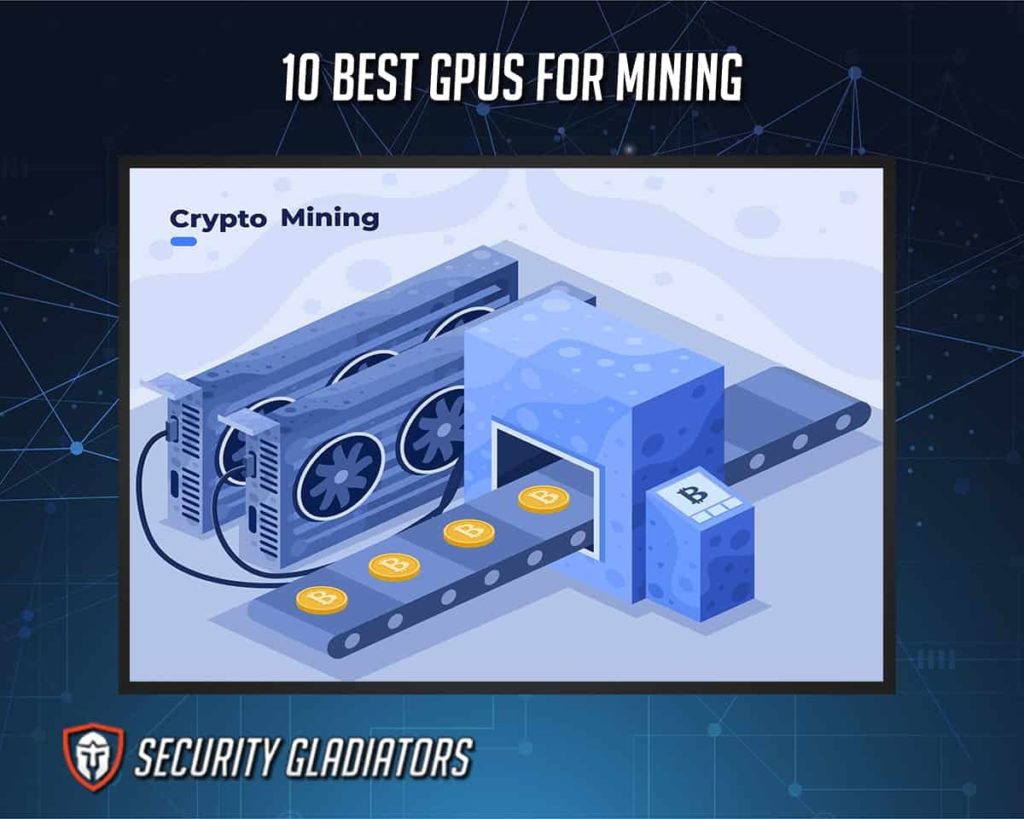
This article covers the top 10 GPUs for mining, as well as some key information relating to GPU use. The top three GPUs for mining are listed below.
- Radeon RX 590 (Best overall)
- GeForce GTX 1080 (Best value)
- GeForce GTX 1070 ti (Best performance)
Table of Contents
1. Radeon RX 590
The Radeon RX 590 came onto the scene in November 2018 as the latest version of the RX 500 series, just a year and a half after the release of the previous version. This unit has the new Polaris 30 graphics process built on a 12-nanometer processor and a memory of 8GB.
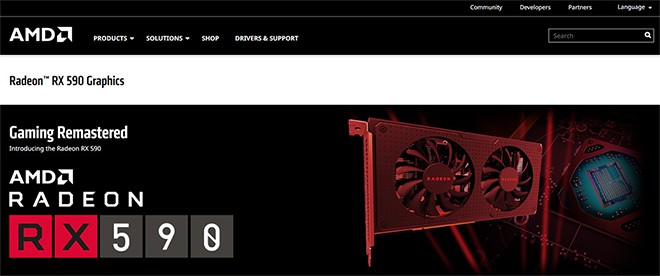
The performance of the Radeon RX 590 is not very different from the Radeon RX 580, but with a higher hashrate, this model became one of the favorites for mining in 2019.
Radeon RX 590 is one of the best GPUs for mining, but as a newer model, this GPU consumes a bit more energy than some competitors. The Radeon RX 590 also consumes about 10% more power than the Radeon RX 580. The difference may not be huge, but is worth taking into consideration for users looking to use multiple GPUs for mining. Energy consumption can accumulate, especially for miners who want to maximize profit in as little time as possible.
Concerning sustainability in mining, the Radeon RX 590 is one of the best choices. This model can reach a hashrate of approximately 31 MH/s. With this speed, users can mine Ethereum at about $0.015 per day, which is already a good profit for just one GPU.
2. GeForce GTX 1080
The GeForce GTX 1080 was one of the first units to have the Pascal graphics processor when this was released in 2016. Although better models succeeded this model, the GTX 1080 remains a good choice for mining, especially considering that the performance is still close to the GeForce GTX 2060. The GTX 1080 has 8GB of GDDR5X VRAM, a speed of 10 Gbps, and a memory bandwidth of 320 GB/s.
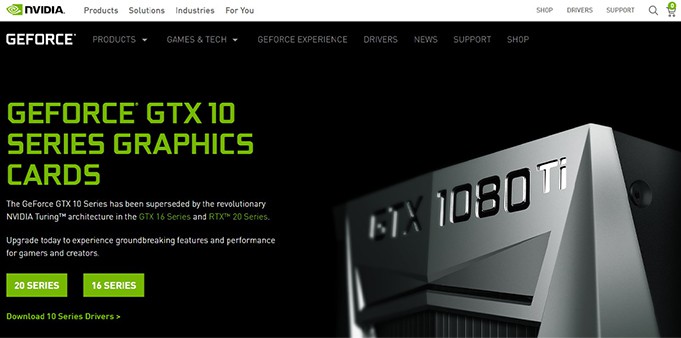
Several things must be considered when choosing a GPU for mining, such as Thermal Design Power (TDP), which refers to the maximum heat a chip can use, expressed in watts. This unit has a TDP of 180 watts and requires only one 8-pin PCIe power connector.
The GeForce GTX 1080 still tops the charts in terms of overall performance and sustainability. When used for mining popular coins like Ethereum, the GTX 1080 can reach a hashrate of about 32 MH/s, slightly lower than the Radeon RX 590. However, with a lower power consumption of approximately 160 watts, this unit becomes more efficient and economical in the long run.
The GTX 1080 is also one of the most popular GPUs for mining other cryptocurrencies such as Zcash and Monero. For Zcash, the GTX 1080 can reach a hashrate of around 700 sol/s. For Monero, on the other hand, the GTX 1080 can reach 1,400 h/s.
3. GeForce GTX 1070 Ti
The GeForce GTX 1070 Ti was released in November 2017 as an upgraded version of the standard version. The Ti at the end of the model name means that this unit is a “titanium” edition, and these versions are typically released as a premium edition of the regular iteration of the model.
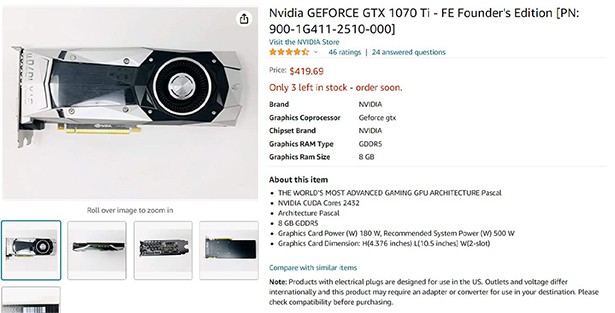
The GTX 1070 Ti has 8GB of GDDR5 VRAM with a speed of 8 Gbps and a memory bandwidth of 256 GB/s. This model also features a TDP of 180 watts and requires only one 8-pin PCIe power connector.
The GTX 1070 Ti falls between the GTX 1080 and the GTX 1070 overall. Concerning raw performance, the GTX 1070 Ti comes close to GTX 1080 but is almost at par with the GTX 1070 in terms of energy efficiency. When used for mining Ethereum, the GTX 1070 Ti can reach a hashrate of about 30 MH/s. This hashrate is almost the same as the GTX 1080 and slightly lower than the Radeon RX 590.
In mining other less popular cryptocurrencies, the main difference between the GTX 1070 Ti from the other units is the higher base clock speed of 1607 MHz and a boost clock speed of 1683 MHz. This speed makes the GTX 1070 Ti more suitable for mining other cryptocurrencies such as Zcash and Monero. For Zcash, the GTX 1070 Ti can reach a hashrate of around 500 sol/s. For Monero, on the other hand, the GTX 1070 Ti can reach 1,200 h/s.
4. Radeon RX 5600 XT
The Radeon RX 5600 XT was released in January 2020 as an upgrade to the previous RX 5600. This model is based on the 7nm RDNA architecture and has 6GB of GDDR6 VRAM with a speed of 14 Gbps and a memory bandwidth of 336 GB/s.
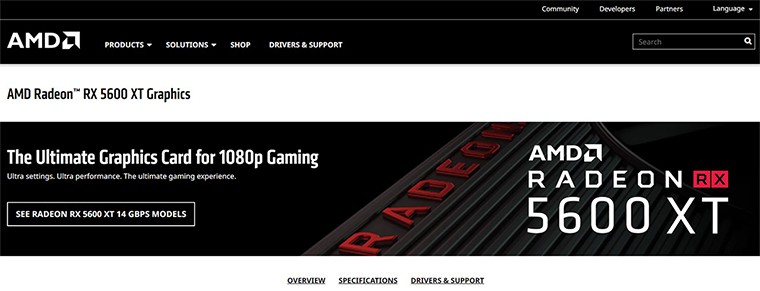
In terms of raw performance, the Radeon RX 5600 XT is one of the best GPUs for mining. When used for mining Ethereum, the RX 5600 XT can reach a hashrate of around 41 MH/s, significantly higher than many of the other models on this list. The Radeon RX 5600 XT also outperforms many of its competitors in terms of power consumption.
The Radeon RX 5600 XT is also a good choice for mining other cryptocurrencies such as Zcash and Monero. For Zcash, the RX 5600 XT can reach a hashrate of around 700 sol/s. For Monero, on the other hand, the RX 5600 XT can reach 1,600 h/s.
5. GeForce RTX 3060 Ti
The GeForce RTX 3060 Ti was released in December 2020 to upgrade to the previous RTX 2060. This model is based on the 8nm Ampere architecture and has 8GB of GDDR6 VRAM with a speed of 14 Gbps and a memory bandwidth of 256 GB/s. Considering raw performance, the GeForce RTX 3060 Ti is one of the best GPUs for mining.
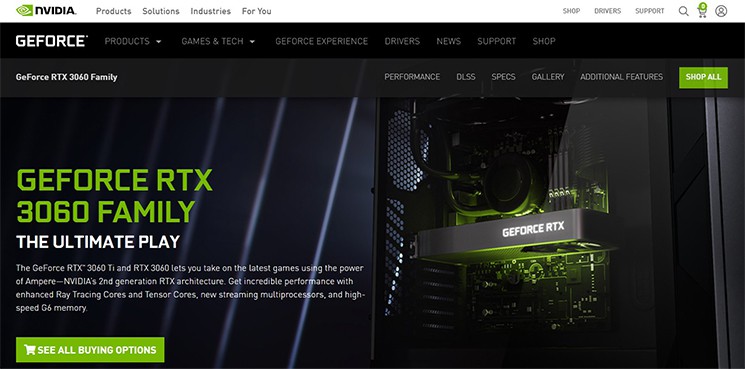
When used for mining Ethereum, the RTX 3060 Ti can reach a hashrate, significantly higher than the other models, of around 44 MH/s. The GeForce RTX 3060 Ti also beats most of its competitors in power consumption. This model has a TDP of only 200 watts and requires only one 8-pin PCIe power connector.
The GeForce RTX 3060 Ti is also a good choice for mining other cryptocurrencies such as Zcash and Monero. For Zcash, the RTX 3060 Ti can reach a hashrate of around 700 sol/s. For Monero, on the other hand, the RTX 3060 Ti can reach 1,600 h/s.
The main downside of the GeForce RTX 3060 Ti is the high price tag, which means that most miners choose a cheaper model. In reality most mining functions can be performed to an acceptable standard with cheaper models.
6. GeForce RTX 2060 Super
The GeForce RTX 2060 Super was released in July 2019 as an upgrade to the previous RTX 2060. This model is based on the 12nm Turing architecture and has 8GB of GDDR6 VRAM with a speed of 14 Gbps and a memory bandwidth of 256 GB/s.
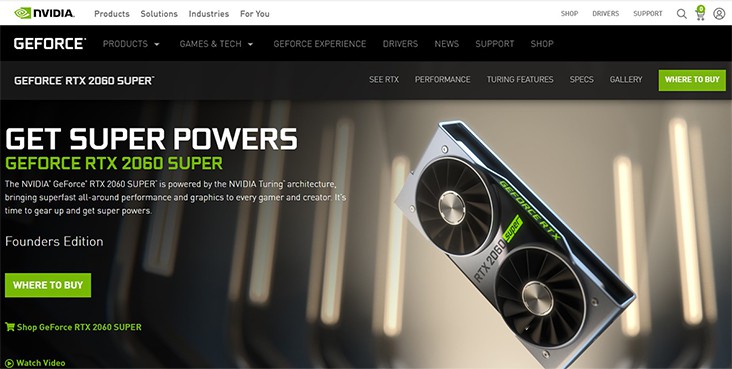
The GeForce RTX 2060 Super has some of the best raw performance on this list and is firmly among the best GPUs for mining. When used for mining Ethereum, the RTX 2060 Super can reach a hashrate of around 36 MH/s, slightly lower than the RTX 3060 Ti but still significantly higher than many other models.
The GeForce RTX 2060 Super is also a good choice for mining other cryptocurrencies such as Zcash and Monero. For Zcash, the RTX 2060 Super can reach a hashrate of around 700 sol/s, similar to other models still keeping up with modern cards. For Monero, on the other hand, the RTX 2060 Super can reach 1,600 h/s.
This card also has a high price tag, considering that this model is not the newest on the market. However, this is still a good choice for miners looking for good performance and efficiency.
7. Radeon RX 5700 XT
The Radeon RX 5700 XT was released in July 2019 as an upgrade to the previous RX 5700. This model is based on the 7nm Navi architecture (a codename of AMD’s new GPU architecture based on 7 nm Vega 2 architecture) and has 8GB of GDDR6 VRAM with a speed of 14 Gbps. This model also has a memory bandwidth of 256 GB/s.
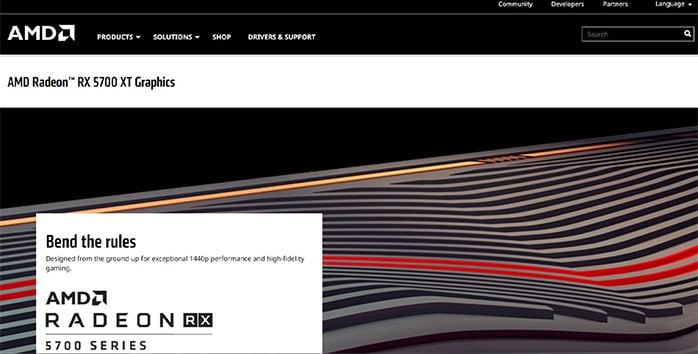
Looking at the GPU’s raw performance, the Radeon RX 5700 XT is one of the best GPUs for mining. The RX 5700 XT’s hashrate can reach around 40 MH/s when used to mine Ethereum. This is slightly lower than the RTX 2060 Super but still significantly higher than most other models on the market.
The Radeon RX 5700 XT has a better power consumption than most available models. Besides being one of the best-performing GPUs for mining, the Radeon RX 5700 XT is also one of the more energy-efficient, with a TDP of 225 watts and requiring only one 8-pin PCIe power connector.
The Radeon RX 5700 XT has a high price tag, but considering the excellent performance, this GPU still represents a good value for money option.
8. GeForce RTX 2070
The GeForce RTX 2070 was released in October 2018 as an upgrade to the previous GTX 1070. This model is based on the Turing architecture and has 8GB of GDDR6 VRAM with a speed of 14 Gbps and a memory bandwidth of 256 GB/s.
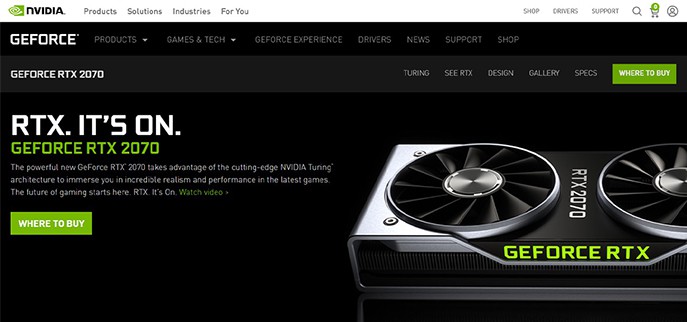
The GeForce RTX 2070 edges most GPU models regarding raw performance, power consumption, and energy efficiency. Reaching a hashrate of around 30 MH/s when mining Ethereum, the GeForce 2070 performs better than most models but slightly lower than the RTX 2060 Super. This GPU’s TDP is 175 watts and requires just one 8-pin PCIe power connector.
The GeForce RTX 2070 is also a good choice for mining other cryptocurrencies such as Zcash and Monero. For Zcash, the RTX 2070 can reach a hashrate of around 700 sol/s, and for Monero, 1,600 h/s.
9. Radeon RX Vega 56
The Radeon RX Vega 56 was released in August 2017 as an upgrade to the previous RX 480. This model is based on the Vega architecture and has 8GB of HBM2 VRAM with a speed of 800 MHz and a memory bandwidth of 410 GB/s. This GPU can reach a hashrate of around 30 MH/s, lower than the RTX 2060 Super but higher than the other GPUs for mining.
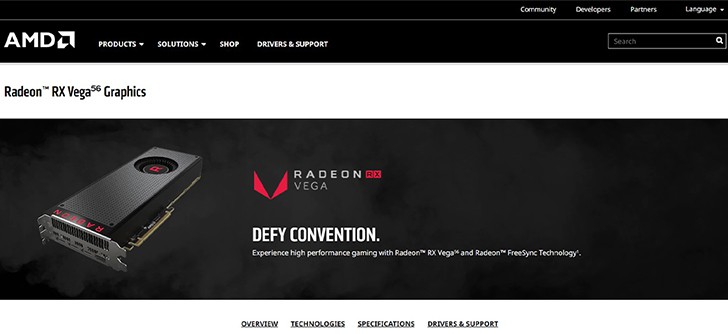
When tested for hashrate in mining BTC, the Radeon RX Vega 56 had a speed of 36 TH/s. This speed is one of the highest hashrates for any GPU on the market and is only bested by the RTX 2080 Ti.
Radeon RX Vega 56 is another excellent choice for mining other cryptocurrencies, such as Zcash and Monero. The RX Vega 56’s TDP hits 210 watts, and like most other GPUs, this only requires one 8-pin PCIe power connector. Overall, the RX Vega 56 performs better in power consumption and speed than most models.
10. GeForce RTX 2080 Super
Being yet another iteration of Super GPU models, the GeForce RTX 2080 Super was released in February 2020. This model is based on the Turing architecture and has 8GB of GDDR6 VRAM, a speed of 15.5 Gbps, and a memory bandwidth of 312 GB/s.
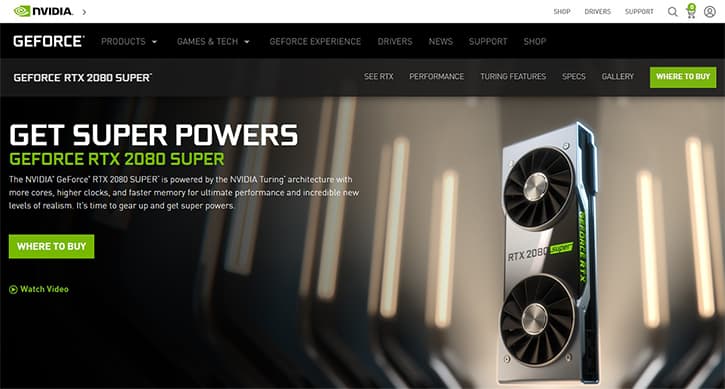
RTX 2080 Super’s raw performance is consistent, making this model one of the best options miners can try. Similarly, this GPU’s power consumption prevails over other models in the market.
Specifically, RTX 2080 Super’s hashrate reaches around 40 MH/s when used in mining Ethereum and around 45 TH/s when mining BTC, bested only by RTX 2080 Ti. This model has a TDP of only 250 watts. Although the energy consumption is slightly higher than other GPUs, the performance is always a good factor to consider.
What Kind of GPU Do I Need for Mining?
Several factors need to be considered when selecting a GPU for mining. The first is the type of cryptocurrency that is being worked with. Ethereum, for example, can be mined with a GPU with at least 3GB of VRAM. Monero, on the other hand, needs at least 8GB of VRAM.
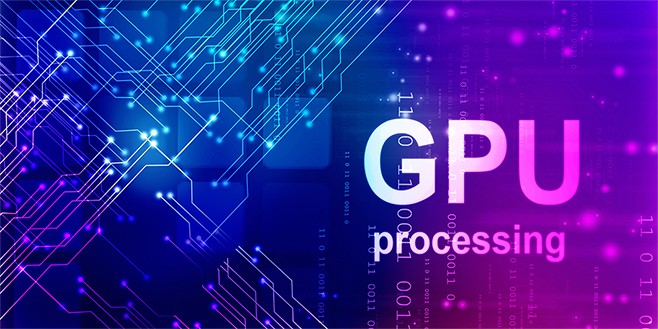
Another factor to consider is the hashrate. Hashrate is a measure of how fast a GPU can mine a cryptocurrency. The higher the hashrate, the faster the GPU can mine.
The third factor to consider is power consumption. GPUs with higher power consumption will require more electricity to run and generate more heat. A large amount of heat can cause damage to the GPU if used without a proper cooling system. These factors will help miners decide which GPU is best for their needs.
Does Mining damage the GPU?
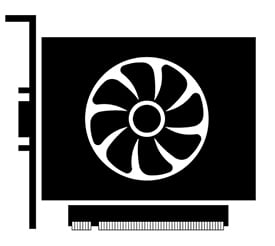
No, mining alone will not damage a GPU. The mining process does not require a GPU to be overclocked, meaning that the GPU will run at lower speeds and will not be stressed as much as when gaming and overclocking for more performance.
Other factors such as dust, overheating, and physical damage can damage a GPU. However, these are all unrelated to mining. Ultimately, the main culprit in damaging GPUs is poor maintenance of the hardware.
How Much Energy do GPUs Need For Mining?
The energy requirement varies depending on the cryptocurrency being mined and the hashrate of the GPU. For Ethereum, for example, a GPU with a hashrate of 30 MH/s will consume around 120 watts. This number can go up or down depending on other factors such as overclocking and cooling.
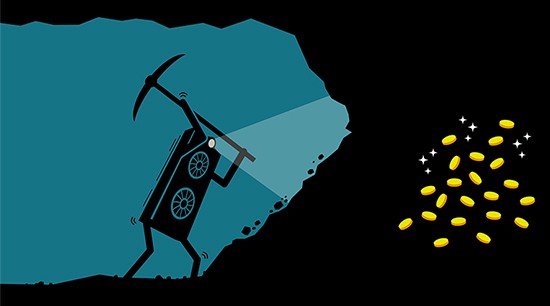
Bitcoin, for instance, is now increasingly demanding more and more energy. As of 2023, approximately 2,188 kWh of energy is needed to complete just one transaction.
As of March 1, 2023, the expected average nominal energy price is $0.1426 per kWh, meaning cryptocurrency mining would translate into an energy bill worth about $312.
What Makes A Good GPU For Crypto Mining?

A good GPU for crypto mining has a high hashrate and low power consumption. This combination will ensure that the GPU can mine for a long time without consuming too much electricity and diluting the profits in the process.
GPUs with high hashrate mean that the unit can solve more cryptographic puzzles needed to validate transactions in a short period, while low energy consumption gives the miner efficiency and minimal waste.
Note:
Miners will also have to consider other factors such as price, availability, and warranty. Some GPUs can be quite expensive, especially some of the newer models, so miners must know the importance of finding one within the budget.Lastly, a good GPU should have a warranty if something goes wrong. Like many electronic products, the warranty ensures the user can obtain a replacement/ refund if the system fails within the warranty time period.
Can Anyone Mine With a GPU?
Yes, anyone can mine with a GPU. All that is required is a computer with a compatible GPU and the proper software. The software will vary depending on the type of cryptocurrency being mined.
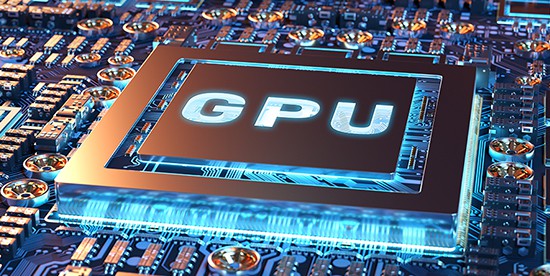
The process of mining can be quite complex and technical. However, there are many resources available online that can help miners get started. These resources can provide the right education and guidance to help miners be successful.
Pro Tip:
Mining can be profitable, but those interested in mining must do the proper research before starting. Researching will ensure that miners know all the risks and rewards before starting.What is the Difference Between CPU and GPU for Mining?
The main difference between using a CPU compared to a GPU for mining is the hashrate. CPUs mine at a slower rate than GPUs because GPUs have more cores and are designed for parallel processing.
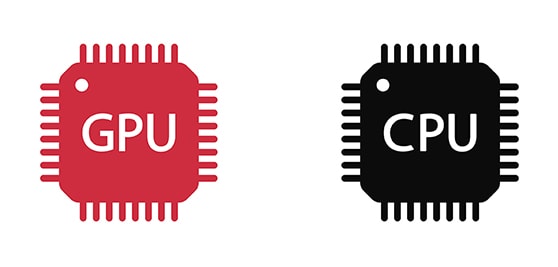
Another difference is power consumption. The best CPU for mining consumes less power than GPUs, so these chips will not generate as much heat. Generating less heat can benefit miners who do not have the budget to invest in a proper cooling system.
Lastly, GPUs tend to be more expensive than CPUs because this hardware is designed for gaming and other demanding applications. Miners must weigh the pros and cons of each type of chip before deciding which one to use for mining.

